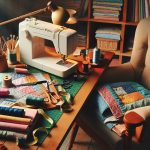Looking to tackle an upholstery project? Look no further! This article is here to provide you with long-lasting wool fabric tips.
Learn how to choose the right fabric, prepare your furniture, and properly cut and measure the wool.
Discover the best sewing and upholstering techniques to ensure a job well done.
And don’t forget about caring for and maintaining your wool upholstery for years to come.
Get ready to transform your furniture with these helpful tips!
Table of Contents
Choosing the Right Wool Fabric
To choose the right wool fabric for your upholstery project, start by considering your specific needs and preferences. Wool fabric selection is crucial in ensuring the success and longevity of your upholstery project. Wool offers numerous benefits for upholstery, making it a popular choice among homeowners and interior designers alike.
One of the key benefits of wool upholstery is its durability. Wool fibers are naturally strong and resilient, making them ideal for furniture that will undergo regular use. This means that your upholstered pieces will be able to withstand the test of time, even in high-traffic areas of your home.
In addition to its durability, wool fabric also offers excellent stain resistance. The natural oils present in wool fibers make it more resistant to liquid spills and stains, making it easier to clean and maintain. This is especially important for upholstered furniture, as accidents happen and spills are inevitable.
Furthermore, wool upholstery provides excellent insulation properties. Wool is known for its ability to regulate temperature, keeping you warm in the winter and cool in the summer. This can create a more comfortable and cozy seating experience, no matter the season.
When selecting wool fabric for your upholstery project, be sure to consider these benefits and choose a fabric that aligns with your specific needs and preferences.
Preparing the Furniture for Upholstery
To prepare the furniture for upholstery, gather all the necessary tools and supplies. Before you can start the upholstering process, it’s important to prime the furniture and remove any old upholstery.
Start by gathering a staple remover, pliers, a rubber mallet, and a flathead screwdriver. These tools will help you remove any staples or nails holding the old fabric in place. Carefully remove the old upholstery, taking care not to damage the frame or padding underneath.
Once the old fabric is removed, inspect the furniture for any necessary repairs or modifications. If there are any loose or broken parts, now is the time to fix them. Clean the furniture thoroughly, removing any dirt or debris that may have accumulated over time. This will ensure a clean and smooth surface for the new upholstery.
Proper Techniques for Cutting and Measuring Wool Fabric
For the proper techniques in cutting and measuring wool fabric, gather the necessary tools and continue the upholstery process by following these steps.
-
Use the right tools: Ensure you have sharp fabric scissors or a rotary cutter to achieve clean and precise cuts. A self-healing cutting mat is also useful to protect your work surface.
-
Measure accurately: Before cutting the wool fabric, measure the dimensions of the upholstery piece carefully. Use a measuring tape or ruler to ensure accuracy. Remember to account for seam allowances if necessary.
-
Mark and cut: Once you have your measurements, mark the fabric with tailor’s chalk or fabric marker. Make sure your marks are clear and easily visible. Use your scissors or rotary cutter to cut along the marked lines, applying even pressure to avoid jagged edges.
When cutting wool fabric, it’s important to take your time and work methodically. Rushing can lead to mistakes and uneven cuts. Always double-check your measurements and markings before making any cuts.
Sewing and Upholstering With Wool Fabric
When sewing and upholstering with wool fabric, ensure you’re using the appropriate needle and thread for the job. Wool fabric is known for its many benefits, such as durability, insulation, and resistance to wrinkles and stains. To make the most of these benefits and ensure a successful sewing project, here are some tips for working with wool fabric.
First, choose a needle that’s suitable for wool fabric. A sharp needle with a fine point, such as a universal or ballpoint needle, will help prevent snagging and damage to the fabric. It’s also important to use a thread that’s strong and compatible with wool. Polyester thread is a good choice, as it offers both strength and flexibility.
When sewing with wool fabric, it’s crucial to handle it with care. Before starting, pre-wash and iron the fabric to remove any sizing or wrinkles. When cutting the fabric, use sharp scissors or a rotary cutter to ensure clean and precise edges. To prevent fraying, finish the raw edges with a zigzag stitch or an overlock stitch.
Another tip for sewing with wool fabric is to use proper stitching techniques. Start by testing your stitch length and tension on a scrap piece of fabric to achieve the desired results. When sewing seams, use a longer stitch length to prevent puckering. To maintain the fabric’s shape and structure, avoid excessive stretching or pulling while sewing.
Caring for and Maintaining Wool Upholstery
When caring for and maintaining wool upholstery, it’s important to follow proper cleaning and maintenance techniques to ensure its longevity. Here are some tips to help you care for your wool upholstery effectively:
-
Vacuum regularly: Use a handheld vacuum or a vacuum cleaner with a soft brush attachment to remove dust, dirt, and pet hair from your wool upholstery. Regular vacuuming prevents the buildup of particles that can damage the fabric over time.
-
Spot clean spills immediately: Accidents happen, so it’s essential to address spills on your wool upholstery promptly. Blot the spill with a clean cloth or paper towel to absorb as much liquid as possible. Avoid rubbing the stain, as it can push it deeper into the fabric. Use a mild detergent mixed with water to gently clean the affected area, and then blot dry.
-
Rotate cushions and rugs: To ensure even wear and tear on your wool upholstery, rotate the cushions periodically. This helps distribute the weight and prevents certain areas from becoming more worn than others. Similarly, rotate wool rugs to prevent excessive fading or wearing in high-traffic areas.
Frequently Asked Questions
Is Wool Fabric Suitable for Outdoor Upholstery Projects?
Yes, wool fabric is suitable for outdoor upholstery projects. It requires special care, but the benefits of wool upholstery include durability, natural moisture-wicking properties, and resistance to fading and staining.
Can Wool Fabric Be Used on Leather Furniture?
Yes, wool fabric can be used on leather furniture. Wool offers many benefits for upholstery, such as its durability, breathability, and natural resistance to flames and odors. It’s a great alternative to synthetic materials.
How Often Should Wool Upholstery Be Professionally Cleaned?
To keep your wool upholstery looking its best, have it professionally cleaned every 12-18 months. Also, learn how to remove stains from wool upholstery and prevent moth damage by regularly vacuuming and using moth repellents.
Can Wool Fabric Be Dyed or Bleached?
Yes, you can dye or bleach wool fabric. There are various dyeing techniques available, using either natural or synthetic dyes. However, it’s important to follow proper instructions and precautions to ensure desired results and avoid damage.
Are There Any Specific Safety Precautions to Consider When Working With Wool Fabric?
When working with wool fabric, it’s important to follow proper handling techniques. Be aware of potential health hazards like allergic reactions or respiratory issues. Take precautions by wearing gloves, masks, and working in a well-ventilated area.
- Styling Tips: What to Wear With Maroon Corduroy Skirt - July 5, 2025
- Stylish Outfit Ideas for Grey Corduroy Pants Women - July 5, 2025
- Stylish Outfits to Wear With a Pink Corduroy Skirt - July 5, 2025






